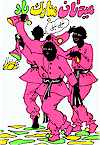
|  |
|---|

What year is it? 2582? 1402? 1444? - How old is NowRuz?
|
Nowruz 2582 (1402, 2023) began on:
با شاد باش نوروز - تحويل سال نو
تحويل سال نو ۲۵۸۲ - ساعت ۰ و ۵۴ دقيقه و ۲۸ ثانيه صبح سه شنبه اول فروردين ۱۴۰۲ در ايران | |||
|---|---|---|---|
| Tehran: | Tuesday: | 00:54:28 AM | March 21, 2023 |
| Berlin | Monday | 10:24:28 PM | March 20, 2023 |
| Chicago: | Monday | 04:24:28 PM | March 20, 2023 |
| Dubai: | Tuesday | 01:24:28 AM | March 21, 2023 |
| London | Monday | 09:24:28 PM | March 20, 2023 |
| Los Angeles | Monday | 02:24:28 PM | March 20, 2023 |
| New York | Monday | 05:24:28 PM | March 20, 2023 |
| Sydney | Tuesday | 08:24:28 AM | March 21, 2023 |

In harmony with the rebirth of nature, the Iranian New Year
Celebration, or NOROOZ, always begins on the first day of spring.
Nowruz ceremonies are symbolic representations of two ancient concepts
- the End and the Rebirth; or Good and Evil.
A few weeks before the New Year, Iranians clean and rearrange their
homes. They make new clothes, bake pastries and germinate seeds as
sign of renewal. The ceremonial cloth
(Sofreh-e Haft Sin)
is set up in each household.
Troubadours, referred to as Haji Firuz,
disguise themselves with makeup
and wear brightly colored outfits of satin. These Haji Firuz, singing
and dancing, parade as a carnival through the streets with tambourines,
kettle drums, and trumpets to spread good cheer and the news of the
coming new year.
Haji Firooz is the black faced character who is the traditional herald of the Nowrooz season and begins to wander the streets and alleyways in his red costume weeks before the end of the year. The sound of his songs and the sight of his dance is often analogous to hearing Christmas music in a shopping mall, telling all that Nowrooz is in the air. Although the blackness of his skin has been the source of some racial controversy in Iranian intellectual circles, Haji's intentions and spirit have always been well received and loved by the people. Haji FiRuz History:
 ]
]
NoRuz Greetings: NoRuz Mobarak (Happy NoRuz, Happy New Year), Eid-eh Shoma Mobarak (Happy New Year to you), NoRuz PiRuz (Wishing you a Prosperous New Year), Sad Saal be in Saal-ha (Wishing you 100 more Happy New Years) Eid-eh Shoma Mobarak ! (happy New Year) |




